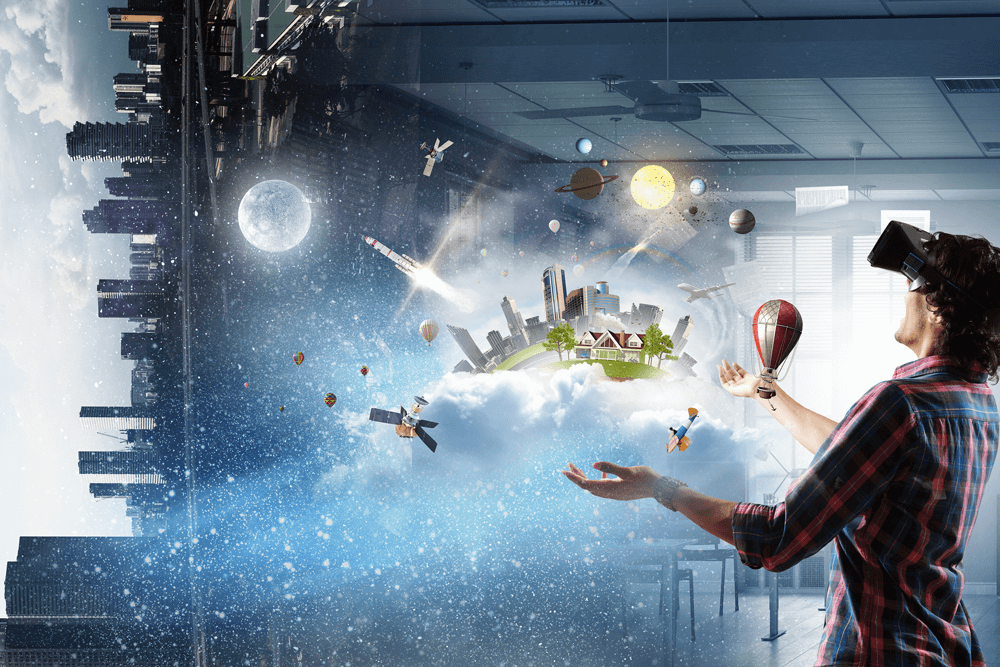The Important Difference Between Virtual Reality And Mixed Reality
2 July 2021
Technologies such as virtual reality and mixed reality have massively increased in popularity over the past 12 months. By 2025, the global immersive reality market is expected to reach $814.7 billion. As virtual and mixed reality are receiving a lot more attention from people beyond the innovative companies that are researching and developing them, there can be confusion about the difference between the them, especially when the technology seems very similar. So, with this article I want to look at the important differences between virtual reality (VR) and mixed reality (MR).

Virtual Reality (VR)
In virtual reality users are fully immersed in a simulated digital surrounding. In recent years, the computer-generated reality they experience has become significantly more believable as a result of realistic graphical and sound content as well as interactive features such as haptic feedback where you feel sensations.
Whether simulating a real environment such as the ocean floor, another country or space or creating a fictional world, virtual reality transports users to an entirely new—virtual—environment that seems like it’s real. Virtual reality technology is the most well-known immersive technology at this point.
A VR head-mounted display or headset is the conduit for the virtual reality experience. It’s connected to a PC or console that has software to create the virtual objects the user sees. There are other VR headsets, such as Samsung Gear VR, Google Daydream or Google Cardboard, that use a smartphone to enable the virtual environment. Oculus Go is a standalone VR headset with the software included as part of the headset. Two video signals are sent to each LCD display on the headset to fool the brain and the user’s binocular vision into believing the virtual environment is actually physical rather than just a scene playing out on a screen.
The entertainment and gaming industries may have been the first to adopt virtual reality technology, but today, VR applications are widely used across many organisations and industries including the military, fashion, business, sports, education, healthcare, construction and engineering, and more. From training for high performance in sports to using virtual reality at a fashion show, the applications for virtual reality continue to expand rapidly.
Mixed Reality (MR)
In a mixed reality environment, real and virtual elements interact with one another, going a step beyond augmented reality (AR) where virtual objects are overlaid on a real world environment. Virtual objects in mixed reality technology co-exist and can be interacted with in real-time in a similar way one would interact with the objects in the real world. For example, wherever you look or go when wearing an MR headset, the 3D content in the space will seem further away or closer to you when you move and offers you different perspectives of the object as you move around them. Microsoft’s HoloLens, Samsung Odyssey, Acer Windows Mixed Reality and Lenovo Explorer are the most well-known MR tools.
Mixed reality is the latest immersive technology and as a result, there aren’t as many publicised use cases of it compared to virtual reality. However, in its latest iteration, HoloLens 2 is an untethered device that Microsoft hopes will have many business applications to help people across an organisation communicate, collaborate and learn together. Ford is using mixed reality technology for business purposes. Is uses the HoloLens to prototype vehicles in a virtual environment to skip over making prototypes in a physical environment which is the conventional production method.
Mixed reality takes a lot more processing power than either virtual or augmented reality and it relies on an MR headset that offers either a holographic experience through translucent glasses or an immersive experience. While less immersive than a virtual reality experience, mixed reality pulls from virtual and augmented realities to join virtual and real worlds to create an extremely believable and effective interaction. Users can interact with the objects thanks to either gesture/gaze/voice recognition technology through a headset or with a pair of motion controllers.
Companies and industries are looking at mixed reality applications to help support several initiatives. Some of these include engineering and design modelling, employee training and education and even uses for mixed reality to aid in the sales process of products.
I help companies understand the potential impact of new technologies and have a lot more articles on MR, VR and AR. For more on augmented, virtual and mixed reality check out this section of my website, or check out this page for other tech trends.
Related Articles
L’Oréal’s AI Weapon Could Kill Traditional Beauty Industry Forever
By now, “smart” versions exist of just about every home appliance, gadget and gizmos we can think of. However, manufacturers continue[...]
Beyond The Hype: What Apple’s AI Warning Means For Business Leaders
By now, “smart” versions exist of just about every home appliance, gadget and gizmos we can think of. However, manufacturers continue[...]
Will Quantum Computing Kill Bitcoin?
By now, “smart” versions exist of just about every home appliance, gadget and gizmos we can think of. However, manufacturers continue[...]
11 Most Reliable AI Content Detectors: Your Guide To Spotting Synthetic Media
Since the launch of ChatGPT just two years ago, the volume of synthetic – or fake – content online has increased exponentially.[...]
The AI-Powered Citizen Revolution: How Every Employee Is Becoming A Technology Creator
Something remarkable is happening in organizations around the world.[...]
6 Mistakes IT Teams Are Guaranteed To Make In 2025
The next wave of artificial intelligence isn't just knocking at enterprise doors - it's exposing fundamental flaws in how organizations approach technology transformation.[...]
Sign up to Stay in Touch!
Bernard Marr is a world-renowned futurist, influencer and thought leader in the fields of business and technology, with a passion for using technology for the good of humanity.
He is a best-selling author of over 20 books, writes a regular column for Forbes and advises and coaches many of the world’s best-known organisations.
He has a combined following of 4 million people across his social media channels and newsletters and was ranked by LinkedIn as one of the top 5 business influencers in the world.
Bernard’s latest book is ‘Generative AI in Practice’.










Social Media